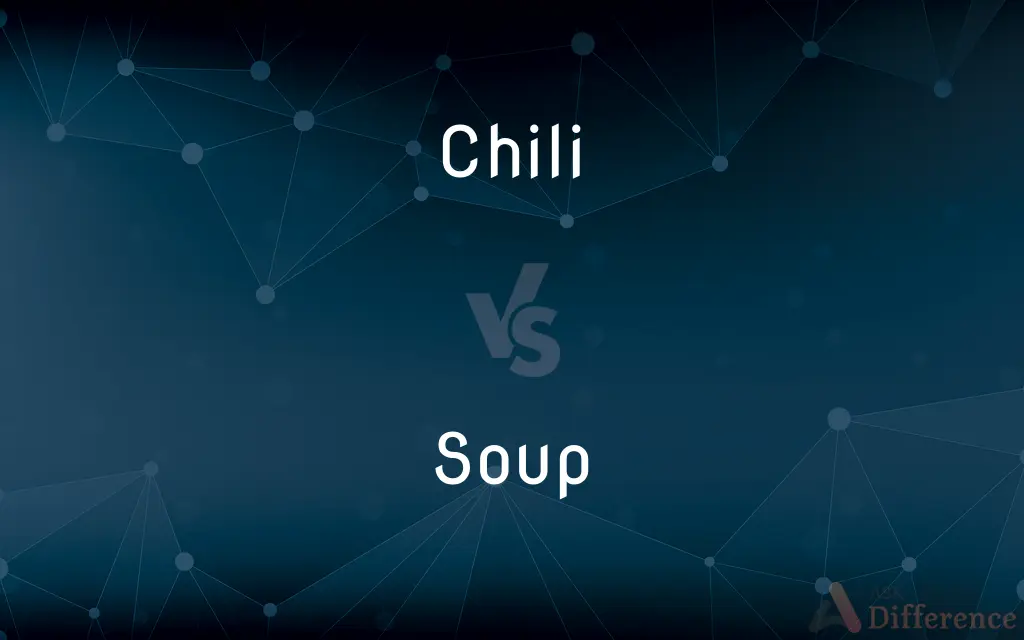Chili vs. Soup — What's the Difference?
By Fiza Rafique & Urooj Arif — Updated on April 5, 2024
Chili is a thick stew of meat and spices, often with beans, while soup is a broader category of liquid dishes, usually broth-based.

Difference Between Chili and Soup
Table of Contents
ADVERTISEMENT
Key Differences
Chili is a hearty dish characterized by its thick consistency and the presence of ground meat, beans, tomatoes, and a variety of spices. It's a staple of Tex-Mex cuisine, often served with toppings like cheese, sour cream, and onions. Soup, on the other hand, encompasses a wide range of liquid dishes. It can be made from a variety of ingredients, including vegetables, meat, and fish, and is often served as a starter or main course. Soups can be broth-based, cream-based, or even cold varieties like gazpacho.
The primary distinction between chili and soup lies in their consistency and ingredients. Chili is known for its thick, stew-like texture and a specific set of ingredients that provide a rich, spicy flavor. Whereas soup offers a greater variety in terms of texture and ingredients. It can range from thin and clear broths to thick, creamy concoctions, allowing for a wide diversity of flavors and culinary traditions.
Chili often requires a longer cooking time to develop its deep flavors and tenderize the meat. This slow cooking process allows the spices and ingredients to meld together, creating a complex taste profile. In contrast, some soups can be prepared quickly, making them a convenient option for a nutritious meal. However, like chili, certain soups also benefit from a longer simmering time to enhance their flavors.
Chili is typically considered a complete meal by itself, often served with sides like cornbread or rice. Its robust nature and substantial ingredients make it filling and satisfying. Soup, while it can also serve as a complete meal, is frequently enjoyed as part of a larger spread or as a light meal option. The versatility of soup makes it adaptable to different meal contexts, from elegant starters to comforting mains.
Comparison Chart
Base
Thick, often tomato-based with meat and spices.
Varied, including broth, cream, or vegetable bases.
ADVERTISEMENT
Ingredients
Primarily meat, beans, tomatoes, and chili spices.
Wide range, from vegetables and meat to grains and noodles.
Texture
Thick and hearty.
Ranges from thin and light to thick and creamy.
Flavor
Spicy and rich, with a focus on meats and beans.
Broad spectrum, from delicate and savory to rich and creamy.
Serving
Often a main course, served with toppings.
Can be a starter, side, or main dish, often without toppings.
Compare with Definitions
Chili
Thick consistency.
The chili had a thick consistency, ideal for scooping up with tortilla chips.
Soup
Can be broth or cream-based.
The mushroom soup was creamy and rich, with a hint of thyme.
Chili
Hearty stew.
For dinner, we had a spicy bowl of chili that warmed us up instantly.
Soup
Global variations.
From Italian minestrone to Japanese miso soup, the variety is endless.
Chili
Served with toppings.
They served the chili with shredded cheese and a dollop of sour cream on top.
Soup
Liquid dish.
On a cold evening, nothing beats a hot bowl of chicken noodle soup.
Chili
Rich in spices.
The secret to her delicious chili is the blend of spices she uses.
Soup
Varied ingredients.
Her vegetable soup is packed with fresh, seasonal veggies.
Chili
Often includes beans and meat.
His chili features a mix of kidney beans and ground beef, simmered to perfection.
Soup
Served as a starter or main.
We started the meal with a light broth soup before the main course.
Chili
The pungent fresh or dried fruit of any of several cultivated varieties of capsicum, used especially as a flavoring in cooking. Also called chili pepper.
Soup
Soup is a primarily liquid food, generally served warm or hot (but may be cool or cold), that is made by combining ingredients of meat or vegetables with stock, milk, or water. Hot soups are additionally characterized by boiling solid ingredients in liquids in a pot until the flavors are extracted, forming a broth.
Chili
A stew made of meat or beans (or both) and usually tomatoes, spiced with chili peppers or chili powder.
Soup
A liquid food prepared from meat, fish, or vegetable stock combined with various other ingredients and often containing solid pieces.
Chili
(countable) The pungent, spicy fresh or dried fruit of any of several cultivated varieties of capsicum peppers, used in cooking.
Chili pepper
Soup
Dense fog.
Chili
(uncountable) Powdered chili pepper, used as a spice or flavouring in cooking.
Chili powder
Soup
Nitroglycerine.
Chili
(Indian Chinese cuisine) A spicy stew of chicken or paneer, capsicum and onion, eaten as an appetizer.
Soup
Primordial soup.
Chili
A dish made with chili peppers and other ingredients, such as beans and beef.
Chili con carne
Soup
A chaotic or unfortunate situation.
Chili
(Cincinnati) Cincinnati chili.
Soup
Any of various dishes commonly made by combining liquids, such as water or stock with other ingredients, such as meat and vegetables, that contribute flavor and texture.
Pho is a traditional Vietnamese soup.
Chili
A kind of red pepper. See Capsicum
Soup
(countable) A serving of such a dish, typically in a bowl.
Chili
Ground beef and chili peppers or chili powder often with tomatoes and kidney beans
Soup
(uncountable) The liquid part of such a dish; the broth.
Chili
Very hot and finely tapering pepper of special pungency
Soup
(figuratively) Any mixture or substance suggestive of soup consistency.
Soup
(slang) Thick fog or cloud (also pea soup).
Soup
Or gelignite, especially when used for safe-cracking.
Soup
(cant) dope (an illicit drug used for making horses run faster or to change their personality).
Soup
(photography) Processing chemicals into which film is dipped, such as developer.
Soup
(biology) A liquid or gelatinous substrate, especially the mixture of organic compounds that is believed to have played a role in the origin of life on Earth.
Primordial soup
Soup
An unfortunate situation; trouble, problems (a fix, a mess); chaos.
Soup
(surfing) The foamy portion of a wave.
Soup
Alternative form of sup
Soup
(uncommon) To feed: to provide with soup or a meal.
Soup
(photography) To develop (film) in a (chemical) developing solution.
Soup
(obsolete) To proselytize by feeding the impoverished as long as they listen to one's preaching.
Soup
Alternative form of sup
Soup
(obsolete) To sweep.
Soup
A liquid food of many kinds, usually made by boiling meat and vegetables, or either of them, in water, - commonly seasoned or flavored; strong broth.
Soup
To sup or swallow.
Soup
To breathe out.
Soup
To sweep. See Sweep, and Swoop.
Soup
Liquid food especially of meat or fish or vegetable stock often containing pieces of solid food
Soup
Any composition having a consistency suggestive of soup
Soup
An unfortunate situation;
We're in the soup now
Soup
Dope (a racehorse)
Common Curiosities
How do the ingredients in chili and soup affect their nutrition?
Both can be nutritious, but their nutritional value varies based on ingredients. Chili is often higher in protein due to meat and beans, while soups can offer a variety of vitamins from vegetables.
Can soup be considered a complete meal?
Yes, soup can be a complete meal, especially when it includes a variety of ingredients like meat, vegetables, and grains.
Is chili considered a type of soup?
While chili shares similarities with soup, it is generally categorized as a stew because of its thick consistency and specific ingredients.
What types of meat can be used in chili?
Chili can be made with a variety of meats, including beef, pork, chicken, and turkey, each contributing to the dish's depth of flavor.
What defines chili as a dish?
Chili is defined by its thick consistency, use of spices, meat, often beans, and its robust, hearty flavor.
Can vegetarian versions of chili be considered authentic?
Yes, vegetarian chili is a popular variation that substitutes meat with additional beans and vegetables, maintaining the dish's characteristic flavors and textures.
Are there any cold soups?
Yes, there are cold soups like gazpacho (a chilled, tomato-based soup from Spain) and vichyssoise (a cold, creamy potato and leek soup).
Is it possible to freeze chili and soup?
Yes, both chili and soup freeze well. Cool them completely before freezing in airtight containers, leaving some space for expansion. They can be stored for several months.
What makes chili different from other stews?
Chili is distinguished by its specific ingredients, such as chili peppers and spices, and its thick texture.
How do regional variations affect the ingredients and taste of chili and soup?
Regional variations reflect local tastes, traditions, and available ingredients, leading to a wide diversity in flavors. For example, Texas chili traditionally does not include beans, while other regions might add various types of beans and vegetables. Similarly, soups vary globally, from the spicy tom yum of Thailand to the rich borscht of Eastern Europe.
How does the cooking time affect the flavor of chili and soup?
Longer cooking times allow flavors to meld and deepen, particularly in chili, where spices and meats benefit from slow simmering. Similarly, soups with robust ingredients also develop richer flavors over time.
What are some common toppings for chili?
Common toppings include shredded cheese, sour cream, chopped onions, sliced jalapeños, and cilantro, allowing individuals to customize the flavor and texture.
How can I thicken my chili or soup if it's too thin?
For chili, simmering without a lid can help reduce and thicken it. Adding tomato paste, masa harina, or cornstarch mixed with water can also thicken both chili and soup.
Can chili and soup be made in advance?
Yes, both chili and soup often taste better the next day after their flavors have had time to meld, making them great make-ahead meals.
Share Your Discovery

Previous Comparison
Unmovable vs. Immovable
Next Comparison
Blush vs. RougeAuthor Spotlight
Written by
Fiza RafiqueFiza Rafique is a skilled content writer at AskDifference.com, where she meticulously refines and enhances written pieces. Drawing from her vast editorial expertise, Fiza ensures clarity, accuracy, and precision in every article. Passionate about language, she continually seeks to elevate the quality of content for readers worldwide.
Co-written by
Urooj ArifUrooj is a skilled content writer at Ask Difference, known for her exceptional ability to simplify complex topics into engaging and informative content. With a passion for research and a flair for clear, concise writing, she consistently delivers articles that resonate with our diverse audience.














































